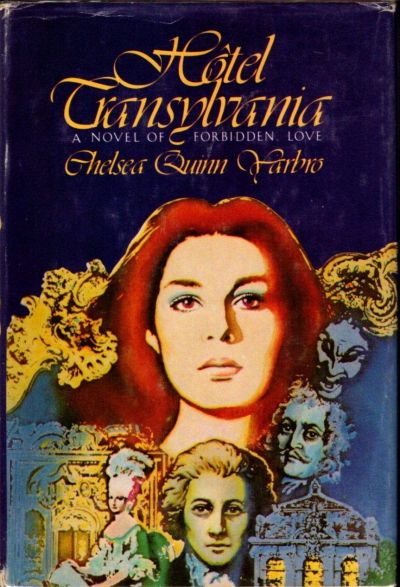Don’t Stand So Close
Hôtel Transylvania (Saint-Germain, volume 1)
By Chelsea Quinn Yarbro

15 Sep, 2024
1978’s Hôtel Transylvania is the first volume in Chelsea Quinn Yarbro’s twenty-seven-plus volume series of fantasy horror historical novels about Le Comte de Saint-Germain.
1743: While the War of Austrian succession rages, Le Comte de Saint-Germain visits Paris. Saint-Germain is a man of mystery. He is also a man of considerable wealth and therefore respectable.
Le Comte is also a vampire.
Saint-Germaine is old enough to have walked the streets of 18th dynasty Egypt1. Largely immune to time himself, he is painfully aware that life is short for ordinary humans. Therefore, he does not squander their lives needlessly, not even to slake his thirst. When possible, he assists the needy. Saint-Germain is in all ways an exemplary gentleman to whom parents should not hesitate to entrust their children.
Clotaire de Saint Sebastien, in contrast, is every bit the monster that Saint-Germain is not. Saint Sebastien is powerful, rich, ambitious, cruel, homicidal, and also a Satanist. Saint Sebastien is determined to expand his lifespan and power through the use of the Dark Arts, regardless of the cost to other people. Indeed, the cost to other people makes his methods even more delightful for Saint Sebastien.
The French aristocracy being what it was in 1743, Saint Sebastien has had great success recruiting aristocrats for his Satanic cult. Alas, there appears to be an inverse relationship between moral flexibility and competence. Perhaps there is a lesson here.
From time to time, Saint Sebastien and his cult carry out a foul rite whose sacrificial victim has to be a virginal, innocent woman. This requires a certain amount of planning. It would not do to discover there were no particularly virtuous women to be had in Paris when the time came for the next sacrifice. Enter young Madelaine de Montalia.
Madelaine is unlike the other women Saint Sebastien has targeted, Madelaine is determined to escape the narrow roles open to aristocratic women. Further, not only does she know Saint-Germain, she has learned what Saint-Germain is. All she need do now is convince Saint-Germain to turn her into a vampire. But before Madelaine can do that, she will have to survive Saint Sebastien’s deadly scheme.
~oOo~
Even for the 1970s, during which rapey fiction abounded, Hôtel Transylvania is super-duper rapey. Just a heads-up. Also, there may be horror novels of this vintage in which gay men are portrayed positively, but this is not one of them.
Hôtel Transylvania was published two years later than Anne Rice’s best-selling Interview with the Vampire. Both novels featured vampires as people, rather than monsters for protagonists to oppose. Both feature characters named Madeleine. It’s natural to wonder if one influenced the other.
I haven’t reread Interview in decades (he said in the mournful tone of a reviewer suspecting that he’s just committed himself to a reread), so my comments must be considered provisional. But it does seem inarguable that while Interview’s Lestat and his pals are self-indulgent (and in Louis’ case, whiney) predators, millennia of undeath have transformed Saint-Germain into something like a saint.
Saint-Germain’s positive qualities are an interesting assortment: he’s good looking, charming, considerate, courageous, charitable, ageless, nearly indestructible2, possessed of superhuman prowess… and almost as sexless as a Ken doll. Certain physical abilities are the monopoly of the living and nobody gets past second (or perhaps second and a half) base with Saint-Germain. Really, the ideal partner for a certain sort of swoony young person like Madelaine.
This was, I think, Yarbro’s second novel. She makes some interesting creative choices. For example, she adopts the 18th century device of the epistolary novel; the narrative is interrupted by many letter excerpts. I don’t think these excerpts moved the plot along. She also indulges in detailed descriptions of everyone’s clothing. If this novel were to be adapted to film, half of the costuming staff’s work would have been done for them. I suspect a lot of homework went into the novel and subsequently onto the pages.
I remember the Saint-Germain novels as being terribly popular. The fact that there were twenty-seven novels in the main sequence and three in the related Atta Olivia Clemens series supports this conclusion.
However, the series’ popularity seems to have vanished in the last decade. While Tor appears to have three of the later books in print, both Open Road Media and Gateway SF seem to have dropped the series. Additionally, ISFDB lists three later Saint-Germain volumes that never saw print. If Hôtel Transylvania itself is in print, that is a closely held secret. When I searched, all I found were pointers to used copies or to editions that do not appear on publishers’ websites.
Has Yarbro suddenly fallen out of favour with readers? Or at least publishers? It’s happened to other authors. Tanith Lee comes to mind. At least with Lee, it was only the American publishers who stopped publishing her. She was still available in the UK. Perhaps a more apt comparison would be Jane Gaskell, a year older than Yarbro, whose works are similarly absent from shelves.
1: Saint-Germain was thousands of years old when Christianity appeared. Not only is he seemingly a convert, certain aspects of it appear to have physical reality. Oh, vampires are not harmed by Christian symbols or holy ground… but Satanists are. Which raises some interesting metaphysical and theological questions.
2: A cynic might ask if nearly indestructible people can be courageous. Well, physical threats are not the only challenges that people can face. Also, we are shown that Saint-Germain will brave raging fires and fire is one of the things that can kill him.
